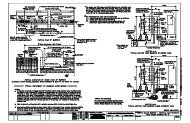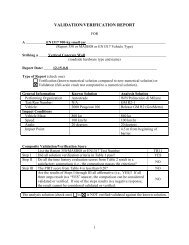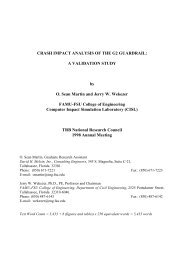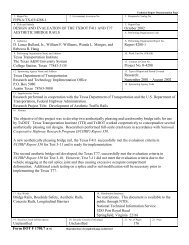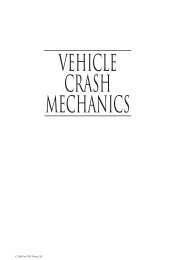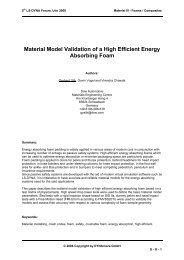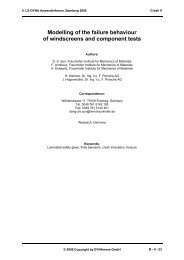Vehicle Crashworthiness and Occupant Protection - Chapter 3
Vehicle Crashworthiness and Occupant Protection - Chapter 3
Vehicle Crashworthiness and Occupant Protection - Chapter 3
You also want an ePaper? Increase the reach of your titles
YUMPU automatically turns print PDFs into web optimized ePapers that Google loves.
Finite Element Analytical Techniques<br />
<strong>and</strong> Applications to Structural Design<br />
Normally, every sheet metal component in the car body is meshed separately<br />
using CAD surface data. In order to become a precise model of the sheet in the<br />
midplane, offsets of the surface data are carefully performed. The sheet is then<br />
meshed in a regular way using meshlines that are as much as possible parallel <strong>and</strong><br />
orthogonal to the incoming pressure wave <strong>and</strong> using triangles only where<br />
necessary. Triangles are thus found in areas of mesh transition or areas of high<br />
double curvature (warpage) only. At the assembly of the individual sheets, further<br />
offsets may be necessary in order to guarantee a minimum gap between all parts<br />
so that no initial penetrations are generated. These gaps are also necessary to<br />
ensure a good performance of the contact algorithms <strong>and</strong> avoid deep penetrations<br />
through the midplane of the opposing part.<br />
Once this task of generating the geometrical model has been performed,<br />
connections (spot welds) must be generated without deforming the geometry of<br />
the flanges on the individual sheet metal parts. This task can be completed in a<br />
number of ways <strong>and</strong> currently no clearly superior method can be distinguished.<br />
Several automatic procedures to generate spot weld elements of different kinds<br />
are currently being developed by software vendors as well as by automotive<br />
companies. Some fundamental problems remain, however. One is the real rotational<br />
stiffness of the spot weld, which will be discussed in a subsequent paragraph.<br />
Another problem lies in the desire to make the spot weld element location<br />
independent of the finite element mesh on both flanges. Since flanges are currently<br />
meshed with two elements over the width, automatic generation of a regular<br />
pattern for the spot weld elements proves a rather elusive goal. Still, it should be<br />
appreciated that in a modern vehicle model, between 3,000 <strong>and</strong> 5,000 spot welds<br />
are modeled individually <strong>and</strong> roughly in their exact locations.<br />
Although the car body model accounts for approximately 75 percent of the entire<br />
model, more <strong>and</strong> more care is been given to modeling of the many other vehicle<br />
components. First to be mentioned are structural parts such as the subframe,<br />
doors, hood <strong>and</strong> wings, which use roughly the same modeling rules as the car<br />
body.<br />
Particular care must be given to the connections between car body <strong>and</strong> subframe,<br />
which are often realized by bolts containing rubber bushings. Whereas the<br />
modeling of the rubber parts would require a prohibitively fine mesh in the context<br />
of a full vehicle simulation, it is still necessary to correctly account for the relative<br />
rotations between the body-in-white <strong>and</strong> subframe which can severely influence<br />
the acceleration response calculated in the passenger compartment. Therefore, a<br />
rigid body connection as well as a spring element connection will both lead to<br />
erroneous results. It is necessary to correctly simulate the motion of the bolt in<br />
Page 127



